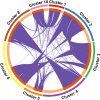Antiretroviral therapy restores the homeostatic state of microglia in SIV-infected rhesus macaques
- PMID: 35686500
- PMCID: PMC9796061
- DOI: 10.1002/JLB.3HI0422-635R
Antiretroviral therapy restores the homeostatic state of microglia in SIV-infected rhesus macaques
Abstract
Microglia and macrophages are essential for homeostatic maintenance and innate immune response in the brain. They are the first line of defense against infections such as HIV/SIV in the brain. However, they are susceptible to infection and function as viral reservoirs even under effective viral suppression. While current antiretroviral regimens successfully suppress viremia and improve quality of life and lifespan, neurologic complications persist and are in part attributed to activated microglia. We sought to test the hypothesis that brain microglia return to a more homeostatic-like state when viremia is suppressed by combination antiretroviral therapy. Using the SIV-rhesus macaque model, we combined single-cell RNA sequencing, bioinformatics, and pathway analysis to compare gene expression profiles of brain myeloid cells under 4 conditions: uninfected, SIV infected, SIV infected with cART suppression, and SIV encephalitis (SIVE). Our study reveals greater myeloid diversity and an elevated proinflammatory state are associated with untreated SIV infection compared with uninfected animals. The development of encephalitis and suppression of viremia both reduced myeloid diversity. However, they had converse effects on the activation state of microglia and inflammation. Notably, suggestive of a restoration of a homeostatic state in microglia, gene expression and activation of pathways related to inflammation and immune response in cART-suppressed monkeys were most similar to that in uninfected monkeys. Untreated SIV infection shared characteristics, especially in brain macrophages to SIVE, with SIVE showing dramatic inflammation. In support of our hypothesis, our study demonstrates that cART indeed restores this key component of the brain's homeostatic state. Summary: ScRNA-seq of rhesus monkey microglia reveals clusters of cells in activated states in the setting of SIV infection, which is primarily reversed by suppressing viremia with combination antiretroviral therapy.
Keywords: HIV; brain; macrophage; neuroHIV; scRNA-seq.
© 2022 The Authors. Journal of Leukocyte Biology published by Wiley Periodicals LLC on behalf of Society for Leukocyte Biology.
Conflict of interest statement
The authors declare no financial conflicts of interest
Figures







Comment in
-
Put them to bed, and "do not disturb" brain microglia in SIV infection.J Leukoc Biol. 2022 Nov;112(5):951-953. doi: 10.1002/JLB.3CE0322-165R. Epub 2022 Aug 16. J Leukoc Biol. 2022. PMID: 35972190 Free PMC article.
References
-
- Burudi EME, Fox HS. Simian immunodeficiency virus model of HIV‐induced central nervous system dysfuntion. In: Buchmeier MJ, Campbell I, eds. Advances in virus research. Academic Press; 2001:431‐464. - PubMed
-
- Desrosiers RC. The simian immunodeficiency viruses. Annu Rev Immunol. 1990;8:557‐578. - PubMed
-
- Lackner AA. Pathology of simian immunodeficiency virus induced disease. Curr Top Microbiol Immunol. 1994;188:35‐164. - PubMed
-
- Zink MC, Spelman JP, Robinson RB, Clements JE. SIV infection of macaques–modeling the progression to AIDS dementia. J Neurovirol. 1998;4:249‐259. - PubMed
Publication types
MeSH terms
Grants and funding
LinkOut - more resources
Full Text Sources
Medical
Molecular Biology Databases

